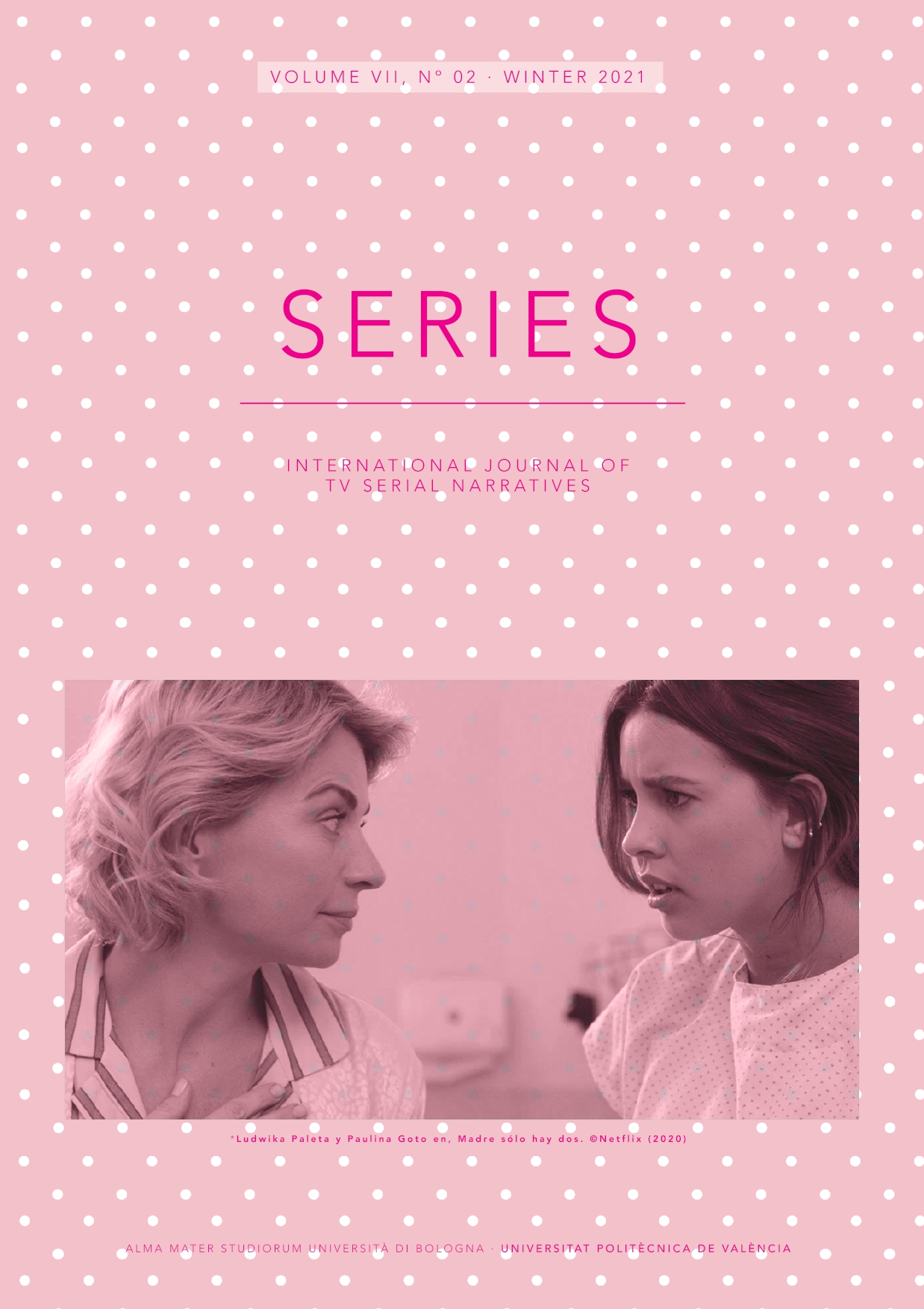Storytelling deviations and attention disputes in Brazilian Netflix originals
DOI:
https://doi.org/10.6092/issn.2421-454X/13247Palabras clave:
poetic analysis, gaining of attention, Netflix Brazil, storytelling deviationResumen
In this article, we seek to highlight and discuss some changes observed in Brazilian Netflix series since 2016 that play an important role in the complexity of the productions. Those changes are expansions in the classical narrative and plot model, with consequent changes in the strategies of information distribution, the effect on how viewer attention is gained and the thematic development of the productions. Regarding the methodology, we adopted a poetic reading based on David Bordwell’s considerations on the classical storytelling model. And we explore the following aspects in the Netflix original series Boca a Boca (2020): the expansion of anticipation of the inciting incident in the narrative structure; the change of the main line of action based on the Multiplot design in the plot structure; and we also analyze the staging solutions that stand out. We concluded that the expansions contributed to a greater demand for viewer attention, in addition to encouraging a diversity of points of view and greater complexity of the theme. The series seems to advance in a more technical way in its articulation of the reference world and the dramatic dimensions, making dramatic motifs preponderate over dramatic themes.
Citas
Alencar, Mauro (2002). A Hollywood brasileira: panorama da telenovela no Brasil. Rio de Janeiro: Senac Rio.
Barros, Roberta Manuela (2003). O fascínio de Scherazade: os usos sociais da telenovela. São Paulo: Anablume.
Bordwell, David (1985). Narration in the Fiction Film. Madison: University of Wisconsin Press.
Bordwell, David (2002). “Intensified Continuity Visual Style in Contemporary American Film.” Film Quarterly 55(3): 16–28. https://doi.org/10.1525/fq.2002.55.3.16.
Campadelli, Samira (1985). A telenovela. São Paulo: Ática.
Campbell, Joseph and Adail Ubirajara Sobral (2004). O herói de mil faces. São Paulo: Cultrix/Pensamento.
Capello, Giancarlo (2016). Una ficción desbordada: narrativa y teleseries. Lima: Fondo editorial Universidad de Lima.
Cornelio-Marí, Elia Margarita (2020). “Mexican Melodrama in the Age of Netflix: Algorithms for Cultural Proximity.” Comunicación y Sociedad (17): 1-27. https://doi.org/10.32870/cys.v2020.7481.
Fadul, Anamaria (1993). Ficção seriada na TV: as telenovelas latino-americanas. São Paulo: ECA-USP.
Jenner, Mareike (2018). Netflix and the re-invention of television. Cambridge: Palgrave Macmillan.
Kincaid, D. Lawrence (2002). “Drama, Emotion, and Cultural Convergence.” Communication Theory 12(2): 136–52. https://doi.org/10.1111/j.1468-2885.2002.tb00263.x.
Lopes, Maria Immacolata Vassalo de (2009). “Telenovela como recurso comunicativo.” MATRIZes 3(1): 21-47. https://doi.org/10.11606/issn.1982-8160.v3i1p21-47
Lopes, Maria Immacolata Vassalo de, Silvia Helena Simões Borelli and Vera da Rocha Resende (2002). Vivendo com a telenovela: mediações, recepção, teleficcionalidade. São Paulo: Summus.
Lotz, Amanda D. (2020). “In between the global and the local: Mapping the geographies of Netflix as a multinational service.” International Journal of Cultural Studies 24(2): 195-215. https://doi.org/10.1177/1367877920953166.
Martín-Barbero, Jesús and Sonia Muñoz (1992). Televisión y melodrama: géneros y lecturas de la telenovela en Colombia. Bogotá: Tercer Mundo Editores.
Maziotti, Nora (1996). La industria de la telenovela: la producción de ficción en América Latina. Buenos Aires: Paidós.
Maziotti, Nora (2006). Telenovela: industria y prácticas sociales. Buenos Aires: Grupo Editorial Norma.
McKee, Robert (1997). Story: Substance, Structure, Style and the Principles of Screenwriting. New York: ReganBooks.
Meimaridis, Melina, Daniela Mazur and Daniel Rios (2021). “De São Paulo a Seúl: las estrategias de Netflix en los mercados periféricos.” Comunicación y Sociedad (18): 1-26. https://doi.org/10.32870/cys.v2021.8038.
Meimaridis, Melina, Daniela Mazur and Daniel Rios (2020). “The Streaming Wars in the Global Periphery: A Glimpse from Brazil.” Series-International Journal of TV Serial Narratives 6(1): 65-76. https://doi.org/10.6092/issn.2421-454X/10457.
Orozco, Guillermo (2020). Televisión en tiempos de Netflix: una nueva oferta mediática. Guadalajara: Universidad de Guadalajara.
Ortiz, Renato; Silvia Helena Simões Borelli and José Mauro Ortiz Ramos (1989). Telenovela: história e produção. São Paulo: Editora Brasiliense.
Phelan, James (1989). Reading People, Reading Plots: Character, Progression, and the Interpretation of Narrative. Chicago: University of Chicago Press.
Picado, Benjamim (2019). “Encenação e Aspecto: inflexões estilísticas na mise en scène da obra seriada televisiva de Aaron Sorkin.” Aniki 6(1): 82-106. https://doi.org/10.14591/aniki.v6n1.453.
Rocha, Simone M., Livia M. C. Arantes, and Marcos Vinícius Meigre Silva (2021a). “Expansões do storytelling e disputas da atenção em Boca a Boca.” Presented at Narrative, Media and Cognition VI – Reconfigurations: New Narrative Challenges of the Moving Image, Lisbon, Portugal, October 2021.
Rocha, Simone M., Marcos Vinícius Meigre Silva, Wanderley Anchieta, Mariana Almeida Ferreira, and Livia Maia Caldeira Arantes (2021b). “Expansões do Modelo Clássico de Storytelling e a Conquista Atencional em Produções da Netflix no Brasil: 3%, Coisa Mais Linda e Boca a Boca.” Presented at the XXX Encontro Anual da Associação Nacional dos Programas de Pós-graduação em Comunicação, São Paulo, Brasil, July 2021. Available at <https://proceedings.science/compos/compos-2021/papers/expansoes-do-modelo-classico-de-storytelling-e-a-conquista-atencional-em-producoes-da-netflix-no-brasil--3---coisa-mais-?lang=pt-br>. Accessed: nov 14, 2021.
Silva, Marcel V. B. (2014). “Cultura das séries: forma, contexto e consumo de ficção seriada na contemporaneidade.” Galaxia 14(27): 241-252. https://dx.doi.org/10.1590/1982-25542014115810.
Silva, Marcel V. B. (2015). “Origem do drama seriado contemporâneo.” MATRIZes 9(1): 127-143. https://doi.org/10.11606/issn.1982-8160.v9i1p127-143.
Sternberg, Meir (1992). “Telling in Time (II): Chronology, Teleology, Narrativity.” Poetics Today 13(3): 463. https://doi.org/10.2307/1772872.
Descargas
Publicado
Cómo citar
Número
Sección
Licencia
Derechos de autor 2021 Simone Rocha, Livia Arantes, Marcos Silva

Esta obra está bajo una licencia Creative Commons Reconocimiento 3.0 Unported.




